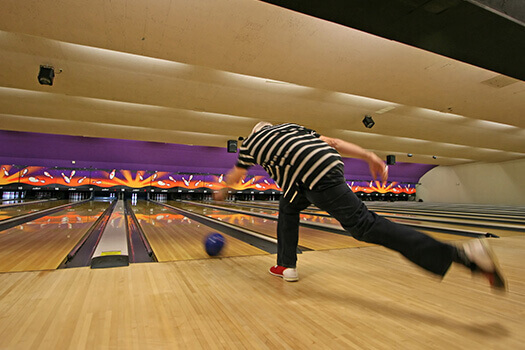
Dating back to ancient Egypt in its earliest form, bowling is more physical than you may realize. During a typical game, most bowlers have to lift, bend, and stretch. And while bowling is certainly a fun activity, the movements involved may contribute to sore back-supporting muscles, especially if you already have a history of spine-related issues. Before you toss your next bowling ball down the lane, consider some of the common causes of bowling-related back pain.
1. Improper Technique
Bowling involves more than just tossing the ball and hoping to knock down a lot of pins. Not paying attention to form and technique could result in pulled muscles or a twist or turn that compresses a nerve near your spine. In bowling, proper technique means:
- Keeping your bowling hand underneath the ball
- Moving your bowling arm out and back
- Releasing the ball when it’s in line with your ankle
2. Bowling Ball That’s Too Heavy
Just because most pros use 14 to 16-pound bowling balls doesn’t mean this weight is right for you. Pay attention to the weight when choosing your preferred bowling ball, especially if you’re going to invest in one you’ll be using consistently.
Balls come in weights that typically range from 6 to 16 pounds. The general rule is 1 pound per every 10 pounds of body weight plus one. For instance, a 120-pound person would select a 12 to 13-pound bowling ball.
3. Overuse of Back-Supporting Muscles
The hamstrings, quadriceps, and calf muscles are among the muscle groups involved with bowling, and arm swings work the forearm and upper back muscles. All these soft tissues either directly or indirectly support your spine. If you’re overdoing it, fatigued muscles may contribute to:
- Muscle strain and/or spasms
- Degenerative disc disease (worn spinal discs)
- Inflammation that affects nerves
4. Not Getting Enough Exercise Between Games
If the muscles that take some of the burden off your spine aren’t strong, your backbone and its discs and joints will be absorbing more stress as you bowl. Even taking 5 to 10 minutes to do some stretches before a game can be beneficial. When not bowling, any of the following forms of exercise may keep your muscles flexible and strong:
- Casual walking
- Core strengthening exercises (e.g. plank holds, side bends)
- Water-based exercises
- Controlled-movement disciplines like yoga and Pilates
5. Shoes That Lack Sufficient Traction
The shoes you rent at your local bowling alley may not have enough traction left to prevent you from slipping or falling as you thrust the ball forward down the lane. If you bowl regularly, invest in a good pair of shoes. Otherwise, do a visual inspection of your rental shoes to ensure there’s sufficient traction on the bottom to prevent injuries that could affect your back.
Even if you’re not one of the 2 million or so Americans in a bowling league, it’s still important to pay attention to back pain that either comes on suddenly or slowly develops when you’re done with your game. If your discomfort doesn’t go away with some heat and ice applications, over-the-counter medications, or a couple days of rest, see your doctor or a Santa Monica spine surgeon before attempting to make your next strike.
In some cases, bowling-related back pain may be severe enough to require minimally invasive back surgery. Santa Monica residents can trust the expert surgeons at The Spine Institute to diagnose the source of their pain and help them find an effective means of relief. Call 310-828-7757 today to schedule an appointment.